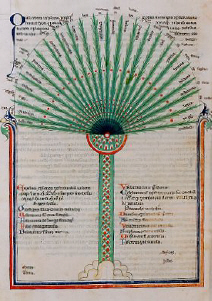1. Are not Being and Reality (to on and he ousia) distinct; must we not envisage Being as the substance stripped of all else, while Reality is this same thing, Being, accompanied by the others – Movement, Rest, Identity, Difference – so that these are the specific constituents of Reality?
The universal fabric, then, is Reality in which Being, Movement, and so on are separate constituents.
Now Movement has Being as an accident and therefore should have Reality as an accident; or is it something serving to the completion of Reality?
No: Movement is a Reality; everything in the Supreme is a Reality.
Why, then, does not Reality reside, equally, in this sphere?
In the Supreme there is Reality because all things are one; ours is the sphere of images whose separation produces grades of difference. Thus in the spermatic unity all the human members are present undistinguishably; there is no separation of head and hand: their distinct existence begins in the life here, whose content is image, not Authentic Existence.
And are the distinct Qualities in the Authentic Realm to be explained in the same way? Are they differing Realities centred in one Reality or gathered round Being – differences which constitute Realities distinct from each other within the common fact of Reality?
This is sound enough; but it does not apply to all the qualities of this sphere, some of which, no doubt, are differentiations of Reality – such as the quality of two-footedness or four-footedness – but others are not such differentiations of Reality and, because they are not so, must be called qualities and nothing more.
On the other hand, one and the same thing may be sometimes a differentiation of Reality and sometimes not – a differentiation when it is a constitutive element, and no differentiation in some other thing, where it is not a constitutive element but an accidental. The distinction may be seen in the [constitutive] whiteness of a swan or of ceruse and the whiteness which in a man is an accidental.
Where whiteness belongs to the very Reason-Form of the thing it is a constitutive element and not a quality; where it is a superficial appearance it is a quality.
In other words, qualification may be distinguished. We may think of a qualification that is of the very substance of the thing, something exclusively belonging to it. And there is a qualifying that is nothing more, [not constituting but simply] giving some particular character to the real thing; in this second case the qualification does not produce any alteration towards Reality or away from it; the Reality has existed fully constituted before the incoming of the qualification which – whether in soul or body – merely introduces some state from outside, and by this addition elaborates the Reality into the particular thing.
But what if [the superficial appearance such as] the visible whiteness in ceruse is constitutive? In the swan the whiteness is not constitutive since a swan need not be white: it is constitutive in ceruse, just as warmth is constitutive of the Reality, fire.
No doubt we may be told that the Reality in fire is [not warmth but] fieriness and in ceruse an analogous abstraction: yet the fact remains that in visible fire warmth or fieriness is constitutive and in the ceruse whiteness.
Thus the same entities are represented at once as being not qualities but constituents of Reality and not constituents but qualities.
Now it is absurd to talk as if one identical thing changed its own nature according to whether it is present as a constituent or as an accidental.
The truth is that while the Reason-Principles producing these entities contain nothing but what is of the nature of Reality, yet only in the Intellectual Realm do the produced things possess real existence: here they are not real; they are qualified.
And this is the starting-point of an error we constantly make: in our enquiries into things we let realities escape us and fasten on what is mere quality. Thus fire is not the thing we so name from the observation of certain qualities present; fire is a Reality [not a combination of material phenomena]; the phenomena observed here and leading us to name fire call us away from the authentic thing; a quality is erected into the very matter of definition – a procedure, however, reasonable enough in regard to things of the realm of sense which are in no case realities but accidents of Reality.
And this raises the question how Reality can ever spring from what are not Realities.
It has been shown that a thing coming into being cannot be identical with its origins: it must here be added that nothing thus coming into being [no “thing of process”] can be a Reality.
Then how do we assert the rising in the Supreme of what we have called Reality from what is not Reality [i.e., from the pure Being which is above Reality]?
The Reality there – possessing Authentic Being in the strictest sense, with the least admixture – is Reality by existing among the differentiations of the Authentic Being; or, better, Reality is affirmed in the sense that with the existence of the Supreme is included its Act so that Reality seems to be a perfectionment of the Authentic Being, though in the truth it is a diminution; the produced thing is deficient by the very addition, by being less simplex, by standing one step away from the Authentic.
